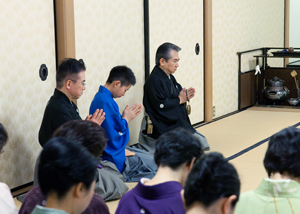Fuden-An: Leaves from a Tea-Journal
Sairai ‘return again’
The way that leaders always ought to be
KOBORI Sojitsu (the 13th Grand Master of the Enshu Sado School )
 This year was marked by a succession of cold days but now that we have entered April, spring has finally arrived. I wonder how long it has been since the last time the cherry blossoms began flowering in April. In recent years, the cherry blossoms began flowering in mid March and people had begun associating them with graduation ceremonies instead of what they are traditionally associated with, school entrance ceremonies, but fortunately the tradition seems to be intact this year. Every year I serve as a director of my alma mater and as part of my duties I attend many school entrance ceremonies at the beginning of April. When I see the happy faces of parents and their children, having their photo taken in front of their school entrance under a flurry of falling cherry blossoms, I can’t help but smile myself.
This year was marked by a succession of cold days but now that we have entered April, spring has finally arrived. I wonder how long it has been since the last time the cherry blossoms began flowering in April. In recent years, the cherry blossoms began flowering in mid March and people had begun associating them with graduation ceremonies instead of what they are traditionally associated with, school entrance ceremonies, but fortunately the tradition seems to be intact this year. Every year I serve as a director of my alma mater and as part of my duties I attend many school entrance ceremonies at the beginning of April. When I see the happy faces of parents and their children, having their photo taken in front of their school entrance under a flurry of falling cherry blossoms, I can’t help but smile myself.
On March 11th this year, we held a tea ceremony event at the Tokyo Art Club. Due to the Great East Japan earthquake we had to cancel the event last year, making this year’s event the first in two years. Coincidentally, as is customary, the event was held on the second Sunday of the month which happened to be March 11th.
At the kucha ceremony held ahead of the tea ceremony at the Tokyo Art Club, in the company of the respective heads of our schools of I used two Tenmoku tea bowls to make offerings to those who lost their lives in the disaster and hope their souls rest in peace. At the tea ceremony, I asked Mr. Kendo Nezu and Mr. Munenobu Tanimura to be the chief servers at the ceremony and carry out the kakekama.
At this ceremony where koicha (thick tea) was enjoyed, we used ‘sairai’, a vase which is particularly well known among all the original Enshu vases made of bamboo. Last year, it had been decided to use the same vase but since were unable to hold the ceremony due to the disaster, since we were finally able to hold the ceremony this year, the meaning of ‘sairai’, to ‘return again’, was particularly meaningful.
While it may not be necessary to explain ‘sairai’ in much detail, the vase was originally given to Enshu by Takuan Nakarai and there is an anecdote about how Enshu removed the ring attached to the upper half of the vase because the dimensions of the dual layered vase were not ideal. This marked the beginning of the ringless dual layered vase. A new tool was born from originality and ingenuity and this tool has until this day remained a type of bamboo vase unique to Enshu. While it was originally intended to be hung on the wall, the vase is also beautiful standing. In the same way that the bamboo flute is representative of Rikyu, Sairai is equally representative of Enshu’s ‘kireisabi’, or ‘pure elegance’.
I received a request from the chief tea server that I place a flower in Sairai. Until now, there have been very few occasions that this vase was used in tea ceremony. Soukei Kobori once used the vase at a large ceremony where we celebrated 350 years of Enshu history, but at the time it was only used so that people could have their photograph taken with it. I decided that I would use the same kamohonnami, a type of camellia, and kibushi flowers my father used 16 years ago. Since it had been a cold year until then, I had feared my hopes would be crushed, but thankfully we managed to get hold of two very fine specimens of both flowers.
This was an opportunity for myself, like my father and Enshu masters before us, to place a flower in this vase, aptly named considering the critical need for reconstruction in the disaster struck area. It was also a sairai in terms of the materials used for the flower arrangement. With these thoughts in mind, I held the camellia in one hand, cut it with scissors and I was able to place it and also the kibushi flower (stachyurus praecox) in the vase in one go. I was deeply moved.

